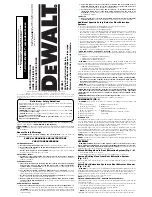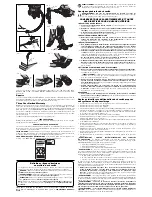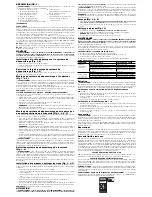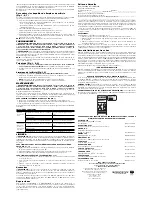
INSTRUCTION MANUAL
GUIDE D’UTILISATION
MANUAL DE INSTRUCCIONES
DWH050
Drilling Dust Extraction System
Système de dépoussiérage pour le perçage
Sistema de extracción de polvo de taladrado
INSTRUCTIVO DE OPERACIÓN, CENTROS DE SERVICIO Y PÓLIZA DE
GARANTÍA.
ADVERTENCIA:
LÉASE ESTE INSTRUCTIVO ANTES DE
USAR EL PRODUCTO.
D
E
WALT Industrial Tool Co., 701 East Joppa Road, Baltimore, MD 21286
(MAY11) Part No. N111555 DWH050 Copyright © 2011 D
E
WALT
The following are trademarks for one or more D
E
WALT power tools: the yellow and black color scheme; the “D” shaped
air intake grill; the array of pyramids on the handgrip; the kit box configuration; and the array of lozenge-shaped humps
on the surface of the tool.
Definitions: Safety Guidelines
The definitions below describe the level of severity for each signal word. Please read the
manual and pay attention to these symbols.
DANGER:
Indicates an imminently hazardous situation which, if not avoided,
will
result
in
death or serious injury
.
WARNING:
Indicates a potentially hazardous situation which, if not avoided,
could
result in
death or serious injury
.
CAUTION:
Indicates a potentially hazardous situation which, if not avoided,
may
result in
minor or moderate injury
.
NOTICE:
indicates a practice
not related to personal injury
which, if not avoided,
may
result in
property damage
.
IF YOU HAVE ANY QUESTIONS OR COMMENTS ABOUT THIS OR ANY D
E
WALT TOOL,
CALL US TOLL FREE AT:
1-800-4-D
E
WALT (1-800-433-9258)
WARNING:
To reduce the risk of injury, read all of this manual carefully before operating
the attachment. Also refer to the manual of any power tool that will be used with this
attachment.
General Safety Warnings
WARNING! Read all safety warnings and all instructions.
Failure to follow the
warnings and instructions may result in electric shock, fire and/or serious injury.
SAVE ALL WARNINGS AND INSTRUCTIONS
FOR FUTURE REFERENCE
1) WORK AREA SAFETY
a)
Keep work area clean and well lit.
Cluttered or dark areas invite accidents.
b)
Keep children and bystanders away while operating a power tool.
Distractions can
cause you to lose control.
c)
Ensure the workplace is well ventilated.
Exposure to dust at a poorly ventilated
workplace may result in damage to the health.
2) ELECTRICAL SAFETY
a)
Avoid body contact with earthed or grounded surfaces such as pipes, radiators,
ranges and refrigerators.
There is an increased risk of electric shock if your body is
earthed or grounded.
3) PERSONAL SAFETY
a)
Stay alert, watch what you are doing and use common sense when operating a
power tool. Do not use a power tool while you are tired or under the influence
of drugs, alcohol or medication.
A moment of inattention while operating power tools
may result in serious personal injury.
b)
Use personal protective equipment. Always wear eye protection.
Protective
equipment such as dust mask, non-skid safety shoes, hard hat, or hearing protection
used for appropriate conditions will reduce personal injuries.
c)
Do not overreach. Keep proper footing and balance at all times.
This enables
better control of the power tool in unexpected situations.
d)
Dress properly. Do not wear loose clothing or jewelry. Keep your hair, clothing
and gloves away from moving parts.
Loose clothes, jewelry or long hair can be caught
in moving parts.
4) POWER TOOL USE AND CARE
a)
Do not force the power tool. Use the correct power tool for your application.
The
correct power tool will do the job better and safer at the rate for which it was designed.
WARNING:
The use of any accessory or attachment or performance of any operation
with this tool, other than those recommended in this instruction manual may present a risk
of personal injury.
b)
Store idle power tools out of the reach of children and do not allow persons
unfamiliar with the power tool or these instructions to operate the power tool.
Power tools are dangerous in the hands of untrained users.
c)
Use the power tool, accessories and tool bits etc., in accordance with these
instructions taking into account the working conditions and the work to be
performed.
Use of the power tool for operations different from those intended could result
in a hazardous situation.
5) SERVICE
a)
Have your power tool serviced by a qualified repair person using only identical
replacement parts.
This will ensure that the safety of the power tool is maintained.
Additional Specific Safety Rules for Dust Extraction
Systems
• Do not use the attachment for drilling applications in wood, steel or plastic.
• Do not use the attachment in core drilling applications.
• Do not use the attachment for chiselling applications.
• Use only power tools recommended by D
E
WALT with this attachment. For more information
about D
E
WALT power tools compatible with this attachment, please contact your local
dealer, call 1-800-4-D
E
WALT (1-800-433-9258) or visit our website www.dewalt.com.
• Do not use the tool in damp or wet conditions.
• Do not allow to be used as a toy. Close attention is necessary when used by or near children.
• Use only as described in this manual. Use only manufacturer's recommended attachments.
• Do not put any object into openings. Do not use with any opening blocked; keep free of lint,
hair and anything that may reduce air flow.
• Keep hair, loose clothing, fingers and all parts of body away from openings and moving parts.
• Do not use to pick up flammable or combustible liquids, such as gasoline, or use in areas
where they may be present.
• This appliance collects a significant percentage of, but not all, the dust generated.
WARNING: ALWAYS USE SAFETY GLASSES.
Everyday eyeglasses are NOT safety
glasses. Also use face or dust mask if cutting operation is dusty. ALWAYS wear certified safety
equipment:
• ANSI Z87.1 eye protection (CAN/CSA Z94.3).
• ANSI S12.6 (S3.19) hearing protection.
• NIOSH/OSHA respiratory protection.
WARNING:
Some dust created by power sanding, sawing, grinding, drilling, and other
construction activities contains chemicals known to the State of California to cause cancer, birth
defects or other reproductive harm. Some examples of these chemicals are:
• lead from lead-based paints,
•
crystalline silica from bricks and cement and other masonry products, and
• arsenic and chromium from chemically-treated lumber.
Your risk from these exposures varies, depending on how often you do this type of work. To
reduce your exposure to these chemicals: work in a well ventilated area, and work with approved
safety equipment, such as those dust masks that are specially designed to filter out microscopic
particles.
•
Avoid prolonged contact with dust from power sanding, sawing, grinding, drilling,
and other construction activities. Wear protective clothing and wash exposed
areas with soap and water.
Allowing dust to get into your mouth, eyes, or lay on the skin
may promote absorption of harmful chemicals.
WARNING:
Use of this tool can generate and/or disburse dust, which may cause serious and
permanent respiratory or other injury. Always use NIOSH/OSHA approved respiratory protection
appropriate for the dust exposure. Direct particles away from face and body.
WARNING: Before beginning the work, check to determine the hazard classification
of the dust produced. Use an industrial dust extractor vacuum of the appropriate
official approved safety class and in compliance with your local dust hazard control
regulations.
WARNING: Always wear proper personal hearing protection.
Under some conditions
and duration of use, noise from this product may contribute to hearing loss.
COMPONENTS (FIG. 1)
WARNING:
Never modify the power tool or any part of it. Damage or personal injury could
result.
A. Hole cleaning nozzle
F. Drilling head release button
[0.32"–0.56" (8–14 mm)]
G. Drilling head
B. Hole cleaning nozzle
[fits drill bit diameters 0–1.47" (0–38 mm)]
[0.56" (14 mm) and above]
H. Drilling head
C. Connection point
[fits drill bit diameters 1.47–2.05" (38–52 mm)]
D. Dust extraction system
I. Suction pad
E. Quick release buttons
INTENDED USE
Your drilling dust extraction system has been designed for professional drilling applications in
concrete and masonry. Using the appropriate hammer drill, drill bit and dust extractor vacuum
it can be used to remove the vast majority of static and airborne dust which without the use of
the dust extraction system could otherwise contaminate the working environment or pose an
increased health risk to the operator and those in close proximity.
Recommended power tools to be used with this attachment are available at extra cost from
your local dealer or authorized service center. If you need assistance in locating any power tool,
please contact D
E
WALT Industrial Tool Co., 701 East Joppa Road, Baltimore, MD 21286, call
1-800-4-D
E
WALT (1-800-433-9258) or visit our website
www.dewalt.com
.
DO NOT
use under wet conditions or in presence of flammable liquids or gases.
The drilling dust extraction system is a professional power tool.
DO NOT
let children come into contact with the tool. Supervision is required when inexperienced
operators use this tool.
ASSEMBLY
WARNING: ALWAYS turn off tool and disconnect the tool from the power source
before making any adjustments or removing or installing attachments or accessories.
This applies to both the drill and the dust extractor vacuum.
Such preventative safety
measures reduce the risk of starting the tool accidentally.
Attach Drilling Head to Dust Extraction System (Fig. 1, 2)
1. Select drilling head (G, H) to be used.
2. Slide drilling head (G, H) into dust extraction system (D) until it locks into place.
Remove Drilling Head from Dust Extraction System
(Fig. 1, 2)
Depress drilling head release button (F) to remove drilling head (G, H) from dust extraction
system (D).
Attach Dust Extraction System to Dust Extractor Vacuum
(Fig. 1, 4, 5)
WARNING:
Use only power tools recommended by D
E
WALT with this attachment. For more
information about D
E
WALT power tools compatible with this attachment, please contact your
local dealer, call 1-800-4-D
E
WALT (1-800-433-9258) or visit our website www.dewalt.com.
Push dust extractor vacuum hose nozzle (K) into connection point (C) until tight. For a more
secure connection use the AirLock connection system.
NOTE:
Ensure hose connection is secure.
AIRLOCK CONNECTOR SYSTEM - DWV9000 (SOLD SEPARATELY)
AirLock allows for a fast, secure connection between the drilling dust extraction system and the
dust extractor vacuum.
1. Ensure the collar (L) on the AirLock connector (M) is in the unlock position. Align notches (R)
on collar and AirLock connector as shown for unlock and lock positions.
2. Push the AirLock connector (M) onto the connection point (C).
3. Rotate the collar (L) to the locked position.
NOTE:
The ball bearings (N) inside collar will lock into slot (O) and secure the connection.
The drilling dust extraction system is now securely connected to the dust extractor vacuum.
If you have questions or comments, contact us.
Pour toute question ou tout commentaire, nous contacter.
Si tiene dudas o comentarios, contáctenos.
1-800-4-D
E
WALT • www.dewalt.com
























